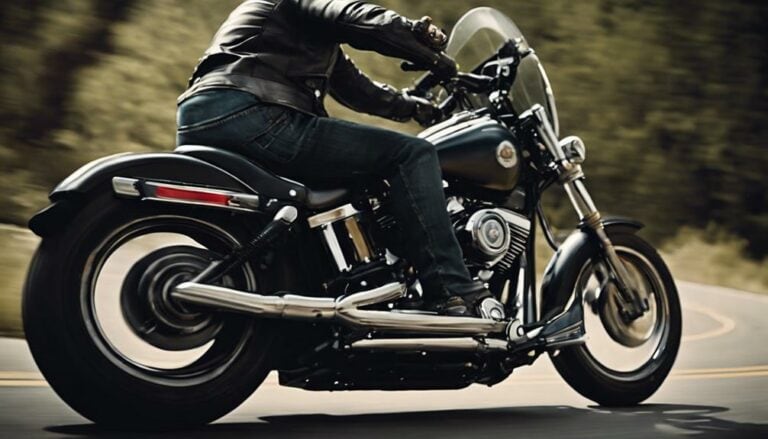When you hit the curves on your Harley Davidson, have you ever considered how much your tires are influencing that smooth ride?
The tires on your bike play a crucial role in determining how well it handles different road conditions and maneuvers.
From the type of rubber used to the tire pressure you maintain, each aspect can either enhance or compromise your riding experience.
So, next time you hop on your Harley, keep in mind that those two wheels beneath you are more than just rubber and tread; they are the key to unlocking the full potential of your ride.
Key Takeaways
- Recommended tires ensure optimal grip, safety, and performance for Harley Davidson motorcycles.
- Tire size impacts handling characteristics like stability, agility, and maneuverability.
- Tread patterns play a vital role in enhancing grip and traction on various surfaces.
- Proper tire pressure is crucial for maximizing cornering ability, stability, and overall handling performance.
Importance of Tires for Harley Davidson
Ensuring the use of Harley Davidson's recommended tires is crucial for maintaining optimal grip, handling performance, and overall safety standards for your motorcycle.
Harley Davidson motorcycles are finely tuned machines, and the tires are a critical component that directly impacts how your bike handles on the road.
These recommended tires have been specifically designed and tested to work in harmony with your Harley Davidson, providing the necessary grip to navigate various road conditions with confidence.
Tire Size and Handling Performance
The handling performance of your Harley-Davidson motorcycle is significantly influenced by the size of the tires installed on it. When considering tire size, it's essential to strike a balance between stability, maneuverability, agility, and cornering capabilities.
Larger tires generally enhance stability and straight-line tracking, promoting a more secure feel at higher speeds. However, they may compromise maneuverability in tight turns. Conversely, smaller tires can improve agility and cornering ability, allowing for sharper and more responsive handling. Yet, they might lead to decreased stability, especially in high-speed situations.
To ensure optimal handling performance, it's crucial to match the recommended tire size for your specific Harley-Davidson model. Any adjustments to tire size should be made thoughtfully, as even slight changes can impact the overall balance of handling traits. By selecting the appropriate tire size, you can fine-tune your motorcycle's characteristics to align with your riding preferences and intended use.
Tire Tread Patterns and Grip
Optimizing the tread patterns on your Harley-Davidson motorcycle tires plays a crucial role in enhancing grip and overall handling performance. The tread pattern directly impacts the traction your tires can generate on different surfaces, affecting how your motorcycle responds to varying riding conditions.
Engineers design specific tread patterns to maximize grip in specific environments, such as wet roads or off-road terrain. Deeper treads excel in providing enhanced traction in challenging conditions, contributing to increased stability and control while riding your Harley-Davidson.
Regularly monitoring tread wear indicators is essential to ensure your tires maintain optimal performance levels. By prioritizing proper tire maintenance and keeping a close eye on tread patterns, you can guarantee consistent handling characteristics for your motorcycle.
Tire Pressure and Cornering Ability
Maintaining the correct tire pressure is essential for maximizing the cornering ability and handling performance of your Harley-Davidson motorcycle. Proper tire pressure ensures optimal traction, stability, and cornering grip, allowing for precise control and responsiveness in corners. Incorrect tire pressure, such as having underinflated tires, can significantly impact the motorcycle's performance, making it feel sluggish and less agile when navigating bends. By adhering to the recommended tire pressure, you can guarantee that your Harley-Davidson motorcycle operates at its peak potential, especially when it comes to cornering and overall handling.
| Aspect | Importance | Impact |
|---|---|---|
| Tire Pressure | Crucial for handling performance | Affects traction, stability, and cornering grip |
| Stability | Enhanced with proper tire pressure | Ensures control and responsiveness in corners |
| Cornering Ability | Maximized through optimal tire pressure | Improves overall performance of the motorcycle |
Impact of Tire Wear on Handling
Proper assessment of tire wear is crucial for understanding how it impacts the handling performance of a Harley-Davidson motorcycle. Here are three key points to consider:
- Tread Depth: Insufficient tread depth due to tire wear can significantly reduce traction, affecting the stability and handling of your motorcycle. It's recommended to replace tires when the tread depth reaches 2/32 inches to maintain optimal handling performance.
- Wear Bars: Check for wear bars located at the base of tread valleys. When these bars become visible, it indicates that the tires are worn out and may be negatively impacting the handling of your motorcycle.
- Uneven Wear: Uneven wear patterns on tires can lead to handling issues and vibrations, signaling potential problems with wheel balance or alignment. Regular maintenance, including monitoring tire wear and addressing any uneven patterns promptly, is crucial to ensure that your Harley-Davidson motorcycle maintains its optimal handling characteristics.
Conclusion
When it comes to handling your Harley Davidson motorcycle, the importance of having the right tires can't be overstated. From the size and tread pattern to the pressure and wear, every aspect plays a crucial role in determining how your bike performs on the road.
Choosing the perfect tires can make all the difference in your riding experience, ensuring optimal grip, stability, and cornering ability. Don't underestimate the impact of your tires on your Harley's handling – it's a game-changer!

